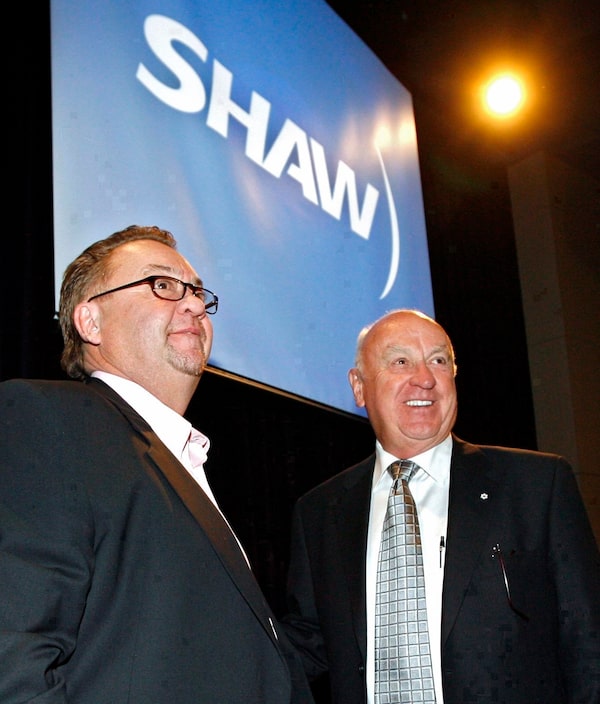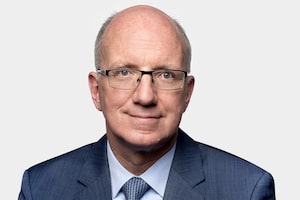
Shaw Communications Inc. says it earned $167 million in its latest quarter, down from a profit of $196 million in the same quarter last year. Shaw logos on display at the company's annual meeting in Calgary, Jan. 17, 2019.Jeff McIntosh/The Canadian Press
It was an arrangement hammered out in the dark and posh confines of the Toronto Club, an environment Ted Rogers was very familiar with. On the other side of the table was JR Shaw, who had travelled from Alberta, where he was considering whether to bid against Rogers Communications Inc. for Maclean-Hunter, the publishing, media and cable conglomerate.
The meeting in 1994 between the heads of Canada’s two top cable TV providers set the stage for a gentlemen’s agreement that would shape competition in the industry for the next quarter century – up until Monday, when Toronto-based Rogers launched its friendly $20.6-billion takeover bid for Shaw Communications Inc.
Rogers seeks to buy Shaw for $20.4-billion in deal that would transform Canadian telecom market
“So here we are in one of these rooms upstairs – one table, two chairs – I thought I was in Buckingham Palace,” Mr. Shaw told author Gordon Pitts, who detailed the key industry moment in his book Kings of Convergence: The Fight for Control of Canada’s Media.
That evening, Mr. Shaw, who died a year ago at 85, agreed to back off on a rival offer if the two companies could divvy up the cable assets by region – Shaw in Western Canada and Rogers in Ontario.
Brad Shaw, CEO of Shaw Communications, answers questions during a news conference at the Shaw AGM in Calgary on Jan. 14, 2014.TODD KOROL/Reuters
Before travelling east, Mr. Shaw had mapped out his family’s aims along with his children, including future chief executive officer Jim Jr., almost like a game of Monopoly. They would pick up 145,000 new subscribers, mainly in the West, and Mr. Rogers would bolster his position in Ontario, with more than 600,000 new customers. It represented an agreement, made by handshake, that the two families would be the cable consolidators in English Canada, “that they would have to work together, and that they would not rock each other’s boat,” Mr. Pitts wrote.
The companies would also agree not to compete in each other’s regions, but not until after Shaw bought up two Toronto-area cable providers shortly after the Maclean-Hunter deal, making it Canada’s No. 2 player after Rogers.
The stage now looks headed for a major reset, with Shaw being folded into Rogers provided the deal passes muster with competition regulators. Led successively by Mr. Shaw, Jim, and now Jim’s younger brother Brad Shaw, the company grew from regional cable TV provider to an integrated telecommunications empire worth more than $12.2-billion. Occasionally, talk turned to the thorny topic of potentially selling the business.
“We constantly discussed where the company is going,” Brad, who has been CEO since 2010, said in an interview. “Some of those conversations were easier than others.”

Jim Shaw, left, CEO of Shaw Communications, and JR Shaw, executive chair, smile following their addresses to shareholders at the company's annual meeting in Calgary in 2008.Jeff McIntosh/The Canadian Press
Brad said he and his family did some corporate soul-searching in 2016 before deciding to sell the company’s media assets, including the Global Television Network, to Corus Entertainment Inc. for $2.65-billion. They did so again the following year, when Shaw sold its data-centre business for $2.3-billion. Both moves paid off. Shaw used the proceeds to buy and expand its Freedom Mobile Inc. cellphone business that is now its fastest growing platform – and an attractive asset for Rogers.
JR exemplified the individualistic style of entrepreneur that Albertans embrace, similar to Max Ward of Wardair Airlines, J.C. Anderson of Anderson Exploration and Ron Southern of Atco Ltd. Yet, Brad said his father understood the logic of selling. The family wants its legacy to be as builders of the leading Canadian telecom platform, and combining forces with Rogers is the best way to achieve that, he said.
“This is a life-changing decision for our family, with generational impact,” Brad said. “Ten years out, I didn’t want to look back and say, ‘I should have done that.’ "
The deal’s impact goes well beyond the family. Shaw Communications is one of Western Canada’s best-known businesses, and a takeover bid by its long-time rival comes at a time of economic crisis in its home province. A major worry is the loss of head offices in Calgary, especially after another former Alberta champion – Encana Corp. – changed its name to Ovintiv Inc. and moved its corporate headquarters to Denver before announcing a round of job cuts in its hometown.
JR Shaw of Shaw Communications.Rudolph Zwamborn
This has not been lost on Rogers and Shaw: They have gone to great lengths to send the message to customers, politicians and Shaw’s 9,500 employees that the deep Western roots will not just be pulled up and forgotten.
Rogers pledged to maintain a base at Shaw’s headquarters in downtown Calgary, and will appoint a president to head it up. In addition, Rogers plans to spend $2.5-billion building up 5G networks in the Western provinces over the next five years, and said it would create 3,000 jobs. It also promised a $1-billion fund to connect Western rural and Indigenous communities.
Ontario-born JR founded the company in Edmonton as Capital Cable Television Co. Ltd. in the 1960s, and after years of lobbying it won its first broadcasting licence from the Canadian Radio-television and Telecommunications Commission in 1970. He was known for his people skills, and “aw shucks” way of expressing himself. He built the company by forming relationships with the owners of small family-run operations, and persuading them to sell.
He could also play hardball. In 1995, he moved the company’s headquarters to Calgary from Edmonton because he felt that the mayor at the time was hampering Shaw’s growth and its ability to invest in fibre-optics infrastructure in Alberta’s capital.
JR Shaw, left, with his son Jim at the company's head office in Calgary in 1998.Jeff McIntosh
JR handed the reins over to Jim in 1998 as Shaw’s market capitalization had topped $2.2-billion. Over the next dozen or so years, Jim expanded the company into an integrated telecom and media player. He also presided over a formal swap of cable assets that followed the 1994 agreement between his father and Mr. Rogers.
As CEO, Jim – who was known for his irreverent and fiercely competitive style – doubled down on acquisitions, buying up more independent cable systems. He bought media assets as well, capping off his tenure in the company’s top job with a deal to buy Canwest’s broadcasting assets for $2-billion in 2010.
Jim Shaw, CEO of Shaw Communication, in the Calgary lobby of his building in 2008.Larry MacDougal/The Globe and Mail
Along the way he pushed Shaw in new directions, offering internet services and launching a home-phone business in competition with the main offerings of its chief Western competitor, Telus Corp. Jim died at 60 in 2018 after a brief illness.
Under Brad, the company modernized its technology and added the final piece to the puzzle with the $1.6-billion acquisition of Wind Mobile in 2016. It renamed the business Freedom Mobile, a competitor to Rogers, Telus and Bell. It also made the company a full-service home and business technology provider, and last year launched its own branded cell-phone service, Shaw Mobile.
When asked by an analyst during a conference call in January if Shaw expected to remain independent given the massive expense required to build out a 5G network, Brad gave no indication that a sale of the family business could be in the offing.
“The family is very comfortable with the trajectory, with the strategy, with the execution. And we’re going to continue to pursue the opportunities we see in front of us,” he said at the time. “And I think there’s more to come. And I think we’re on the right path.”
Brad Shaw Chief Executive Officer of Shaw Communications Inc. effective January 13, 2011 Inc is photographed at the company headquarters in Calgary, 2011.Chris Bolin/The Globe and Mail
Your time is valuable. Have the Top Business Headlines newsletter conveniently delivered to your inbox in the morning or evening. Sign up today.
 Jeffrey Jones
Jeffrey Jones Andrew Willis
Andrew Willis